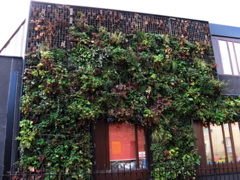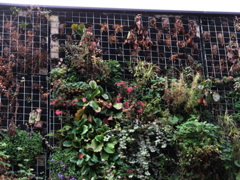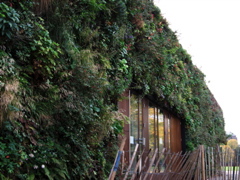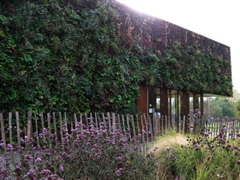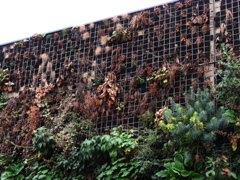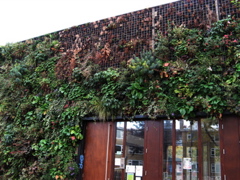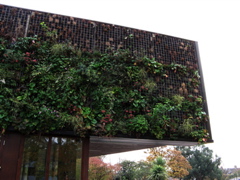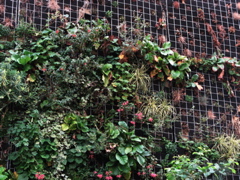From the live art garden initiative
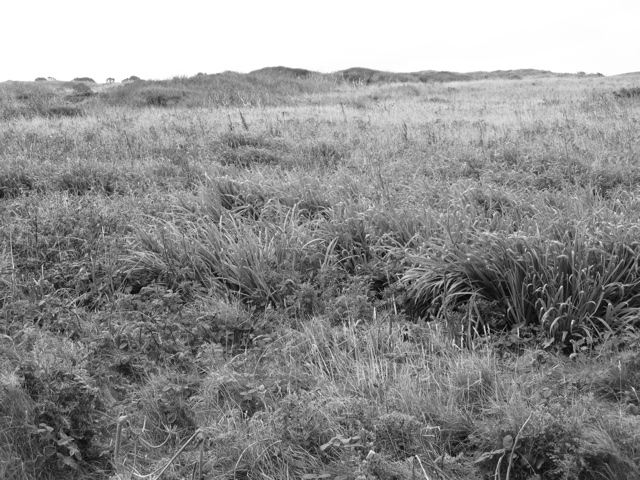
- From the editor
- What's next for the Live Art Garden Initiative?
- What's your carbon footprint?
- Paradise Park's green wall
- New on the Initiative's website
- Call for articles for the next News Update issue
- Media Architecture Conference 2007
- Graffiti Research Lab
- Shigeru Ban Architects
- Patrick Blanc's vertical gardens
- Culture Machine Journal 9: Recordings
- Artquests - opportunities deadlines page
- Live Art Garden Initiative events
- External events
Welcome to the first issue of the Initiative's News Update. The News Update is published and archived on the Initiative's website and circulated to those who have subscribed to the Initiative's mailing and discussion lists upon its release. Its purpose is to keep interested parties in touch with the Initiative's ongoing practice, research and development – particularly aspects, issues and ideas informing work as well as work being undertaken. As development work gradually moves the main project forward, apart from a channel for main project announcements, it is intended that the News Update will facilitate a flow of fruitful communications and exchange, as it enables opportunities for those interested in the Initiative to contribute article content. The next issue will be in four months time.
What's next for the Live Art Garden initiative?
Since the Artist Review Series I have formed a clearer vision of where the Live Art Garden Initiative's long-term project is directed – the series was of great help in this process. Although I now have a clearer vision – it is also still somewhat fuzzy, but I think that this remains important. For instance, there are drawbacks that accompany the premeditation involved in project-planning that for an artist-led project I both want to avoid and yet recognise that I have to negotiate somehow.
Whilst a clearer vision has been arrived at I am still confronted with many impediments which I am not yet certain about how to approach. Although I have identified various pathways, I feel it is essential now to recognise that any next project phase development must be actually grounded, ie, I must locate and acquire extended access to a suitable outdoor site and begin the experimentations there. I have therefore decided that the next Live Art Garden Initiative project phase will encompass what I'm naming a 3 year Site Pilot Project.
Last December I submitted a proposal to the Cultural Leadership Programme for £90k project funding to take an initial concept of the Site Pilot Project forward. Unfortunately the submission was not successful, but I am pursuing other funding opportunities.About the Site Pilot Project research proposal
I have recently drafted a research proposal intended to facilitate undertaking the Site Pilot Project. This latest proposal is currently in need of further collaborative development and although I already now have an extended network of potential participants to invite and project partners in mind and interested, I would welcome hearing from further Higher Education research centres or organisations who may be interested, as additional project partners who are able to offer support and become involved will still be needed on board. The research proposals draft aims include these:-
- To undertake practice-led research facilitated through set-up of, direction and programming of a 3 year Site Pilot Project that is concerned with artists developing and sharing performance works in situ in innovative garden-farm landscapes, in order to problematise directions of transdisciplinary performance art arising through and requiring this type of practice context.
- To develop and disseminate an original knowledge base relevant to the realisation of new long-term site projects of this nature, ie integrated art, architecture, sound, philosophy and ecology projects focussed on in situ live arts.
More about the vision now
Innovative garden-farm landscape for live arts performance represents a new integrated land use concept. Part of the concept is for the integration of new media-architecture that enables installation of interactive technologies and screens. Another challenging aspect is that the garden-farm represents an approach to garden landscape that integrates farming (organic and non-gm in this case) in both experimental and new ways. Foremost though, these new and sustainable landscape vicinities will be envisaged to provide both suitable and innovative sites to engage in live arts practice.
Through the Site Pilot Project it is intended to focus primarily upon potential from field space vicinities, ie new approaches to performance afforded by relatively large spatial scales. However, the project work will not be directed towards spectacle or necessarily require large-scale production costs. Primarily the Pilot is expected to focus on performative work that is neither concerned with narrative or representation, unless exploring the operation of these approaches in complex or unconventional ways.Live Art Garden Initiative – other current activities
At the time of writing, a new schedule of monthly planning-development meetings initially involving the Initiative's associate artists is about to commence. An update about the Site Pilot Project proposal is on the first meetings agenda, but there are also other ideas afoot for discussion. To keep in touch with developments and opportunities to become involved in these please join the Live Art Garden Initiative mailing list or yahoo group discussion listLauren Goode 27 September 2007
Extracts from this article are published in an magazine November 2007 issue
Recent reports released on climate change and carbon emission reduction needs have flagged up that not only are further larger calamities from climate change certain, but that, to mitigate them, adaptation actions will be needed on a scale that is recognised as on both a national and international emergency priority level.
I decided to find out, using the Resurgence Carbon Calculator what my carbon footprint actually was. My result was an enormous 5.3 tonnes for last year. The national average is 10 tonnes per capita – mine happens to be lower mainly because I have not travelled by air and because, frankly, I'm skint (the Resurgence calculator info explains how it is most likely that 'roughly one tonne for every £5k of income per person in the home' should be added when calculating ones income-related share of industrial emmissions, which form part of the emission calculations). For putting this result in further perspective, 'it is estimated that the sustainable CO2 emission quota per capita for each of 6 billion global inhabitants is 2 tonnes per annum' [Resurgence info].
Recently I heard, via The Low Carbon Show on Resonancefm, about the Zero Carbon Britain, Alternative Energy Strategy report by Tim Helweg-Larsen and Jamie Bull. Their report sets out a vision to reach zero emissions in 20 years, which contrasts greatly with Government plans – see below the links to the climate change bill. The Zero Carbon Britain strategy sets out an 'Island Britain Approach, where Britain becomes self-reliant in energy', however it also recognises the necessity of this as 'part of an international process'. It also refers to a Contraction and Convergence (C&C) global framework for reaching global emission targets. (The C&C framework involves: '...having agreed a global carbon budget to stabilise atmospheric CO2 concentrations, a process of contraction of emissions is initiated, with progressively-reducing annual allocations that cumulatively fall within that overall budget).
On another programme re-aired on Resonancefm recently, from Indymedia, covering last Augusts Climate Change Camp at Heathrow, listeners were able to catch presentations given at the camp. (These presentations are probably available as podcasts on the Indymedia site). The presentations included those by George Monbiot and Tim Helweg-Larsen (ZeroCarbonBritain). Whilst both these speakers flagged up the urgency and importance of renewables in the ways forward, interestingly Monbiot spoke, in contrast to an 'Island Britain' approach. He called for some acknowledgement along these lines: that, as it is certainly inevitable that during the coming critical years many individuals will fail to take the necessary steps to reduce their emissions, it would be necessary to compensate for these individuals not converting to small-scale energy renewable generation types, and that this means that it is in fact essential for European Governments to embark on working together on large-scale engineering of european-supergrid systems – networks of renewable projects, for instance, including massive off-shore wind-farms, (eg 100 miles or more off-shore). It seems likely that while ideally regional localities do need to work towards realising local energy production initiatives for a securer long-term – and as soon as possible – the current emergency period does also call for Monbiot's pragmatic approach, ie, accepting the need for large-scale international emergency energy projects that one also is still wise to be wary of because of the drawbacks, such as those commonly associated with centralised power systems as opposed to distributed systems.
- The Coin guide to online carbon calculators
- The Low Carbon Show featuring Tim Helweg-Larsen
- Centre for alternative energy Zero Carbon Britain report Oct 2007
- Climate Camp 2007 – news and podcasts from Indymedia
- UN Global Environment Outlook Report 4 GEO4 Oct 2007
- George Monbiot blog 30 Oct 2007
- Which Energy?. Institute of Science in Society (ISIS) report. 2005/6
- Recommended film: Darwin's Nightmare. 2004. Director: Hubert Sauper
The full climate change bill could become law by March/April 2008. Government climate change links:
- Draft Climate Change Bill. March 2007. Defra. CM 7040
- Taking forward the UK Climate Change Bill The Government response to pre-legislative scrutiny and public consultation. Cm 7225. 29 October 2007
Lauren Goode 7 November 2007
Green walls are probably likely to become increasingly popular, but I wonder how green they are, in contrast to vertical growth in natural environments or compared with organic practice approaches, for instance, in terms of their plant loss, water and nutrient feeding requirements. The images below document the vertical hydroponic garden wall of the Paradise Park's Children Centre in Islington, London, designed by the architects dsdha. An article by QSWeek reports that the cost of the wall was around £90k and that this was 'almost 10% of the total budget'.
'The system, by landscape designer Clarke Associates, integrates a rainwater harvesting tank which collects, distributes and recycles rainwater (topped up by mains supply) and nutrients through an irrigation network which runs through the wall. Some thirty varieties and 7,000 individual plants were planted onto rockwool slabs encased in steel mesh cages which were bolted onto the building’s façade'. QSWeek article
Further details on the construction and costs are published on the AJ site.
Lauren Goode 8 November 2007
New on the Initiative's website
- A moving image page
- Postings continue on This Week
- More content from presentations given at the Artists Review Series events
- A description of a film work idea (in development) by Lauren Goode
Call for articles and content for the next News Update issue
I invite readers to contribute their articles or items for the Content, Featured links or Notices sections of the next News Update issue. Please email any feedback or content contributions to the editor. Articles and items will be considered for inclusion on a case by case basis. However, it is anticipated that mostly they will relate to or be relevant in some way to the Live Art Garden Initiative's transdisciplinary research and practice of which the general areas of interest include:-
- biophysics, acoustics, ecology and sound art;
- landscape, media & interactive architecture and sustainability;
- live art and mixed media performance;
- contemporary philosophy and critical studies.
- Media Architecture Conference 2007 - Video Documentation
I heard about this recent Media Architecture conference via Interactivearchitecture.org. Good news – the conference presentations can now be played from the Media Architecture website. - Graffiti Research Lab
Professor Bart Lootsma cited the work of the Graffiti Research Lab in his presentation at the Media Architecture conference entitled 'Total Immersion'. I checked out their site to find out more. Online you can view many quicktime movies of their project work involving large-scale 'outdoor digital projection in urban environments'. The Graffiti Research Lab is described as 'dedicated to outfitting graffiti artists with opensource technologies for urban communication'. - Shigeru Ban Architects
I'm inspired by Shigeru Ban's work using paper tubes to construct with... - Patrick Blanc's vertical gardens
Patrick Blanc's introduction to his Vertical Garden work states that it involves 'a new way to grow plants without any soil'... - Culture Machine Journal 9: Recordings
This issue is edited by Paul Hegarty and Gary Genosko. Contributers include: Eugene Thacker – Pulse Demons;
Greg Hainge – Vinyl is Dead, Long Live Vinyl: The Work of Recording and Mourning in the Age of Digital Reproduction; Paul Hegarty – The Hallucinatory Life of Tape; Jérôme Hansen – Mapping the Studio (Fat Chance Matmos): Sonic Culture, Visual Arts and the Artist's Studio; Gary Genosko – 8 Track Rhapsody; Ross Harley and Andrew Murphie – Rhythms and Refrains: A Brief History of Australian Electronica; and Dan Hays – Painting in the Light of Digital Reproduction. - Artquests - deadlines page
A helpful page for artists trying to keep track of opportunities and submissions organised by monthly or rolling deadlines
Live Art Garden Initiative events
- Forthcoming events and activities will be posted here
- Intimacy as event – explored through participation in a performance-experiment. 8 Dec. 2007. Part of the Intimacy Conference workshops programme. A workshop devised and led by Lauren Goode, plus guest artists. Call for participants and further details.
External events
- Polar: the art & science of climate change Symposium & talks, November dates. Organiser: Arts Catalyst
- Intimacy Conference 7-9 Dec. 2007. Organiser: Goldsmiths College
- InVivo 4 day laboratory 23, 24, 30 Nov & 1 Dec. 2007. Organiser: InVivo Movement Research Collective
- 16th Festival of Experimental Music 29 Nov - 1 Dec. 2007. Organiser: London Musicians' Collective
Editor: Lauren Goode
Contributers to this issue: Lauren Goode
Published by the Live Art Garden Initiative

